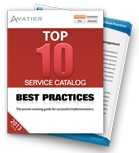November 15, 2013 • Garrett Garitano
Put the BUSINESS in your IT Service Catalog
IT service catalog like shopping. IT Service Management is a hot topic for many CIOs as they strive to improve operations, and implementing a Service Catalog helps the business and IT understand what services they truly provide to the business. Unfortunately, many organizations only focus on an “IT” Service Catalog rather than thinking holistically of the […]

IT Service Management is a hot topic for many CIOs as they strive to improve operations, and implementing a Service Catalog helps the business and IT understand what services they truly provide to the business. Unfortunately, many organizations only focus on an “IT” Service Catalog rather than thinking holistically of the business to implement a “Business” Service Catalog. Just as IT offers services, other business functions also offer services, so any Service Catalog project should incorporate business needs as well as IT needs.
Since IT is often champions a Service Catalog project, it makes sense for IT services to be included, yet IT is really transforming into a business function so it would be foolish to implement an end-user facing solution that only deals with technology requests. IT would gain a lot of respect if during these projects they involve the business to identify common services that all identities need. By including the business in the scope of a Service Catalog project, funding and support would become much easier as well.
From working with a variety of clients, it is amazing to see how many big businesses are spending millions of dollars to implement a service catalog when often the solution merely offers a cumbersome portal with minimal automation capabilities. If the solution is only supporting workflow with the end result of routing a form or details via email, business functions can obviously be included just as easily as IT functions. HR or Legal requests could have their own section in a business service catalog just as IT requests would have their own section too.
Once you have realized that including business services is the right thing to do, you need to design the solution so typical end-users will adopt it. Otherwise, you may deploy a Service Catalog that nobody wants to use, which ultimately results in continued reliance on phone calls to the service desk. Too many organizations implement Service Catalogs that are difficult to use, counterintuitive, and costly to customize and build in the first place.
Unfortunately, many big-name Service Catalog products were designed as an afterthought to be included with broader ITSM product suites. As a result, intuitive interfaces are pretty much nonexistent. Additionally, the act of implementing the solution and changing the solution requires considerable customization and technical effort. With the consumerization of IT, you must understand that users expect IT solutions to match the beauty and intuitiveness they find elsewhere on the Internet, so this must be a high priority when selecting and designing a business service catalog solution. If the user experience is not taken into account, your users will find another way to get work done.
With productivity the goal, make sure you focus on the BUSINESS when implementing a “Business” Service Catalog even if your ITIL playbook focuses primarily on IT needs. This approach elevates IT in the eyes of business leaders while delivering true value to the business. However, be sure you implement a solution that your users embrace or you risk being viewed as someone who doesn’t understand the latest technology and the needs the business.
 Get the Free Top 10 ITIL Service Catalog Best Practices Workbook
Get the Free Top 10 ITIL Service Catalog Best Practices Workbook
A successul Service Catalog roll-out requires careful planning, strategic decision-making and innovation. Before you start your ITIL service catalog initiative, learn from industry experts. Sidestep challenges that derail projects. Get our Top 10 Service Catalog Best Practices — The proven guide for successful implementations.









